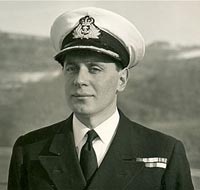 Rear Admiral Peter Branson, who died recently at age 86, had an illustrious career in the Royal Navy. His career almost ended before it began. Branson was twice torpedoed while he was still under training, on one occasion surviving five days adrift in a lifeboat off the coast of Africa.
Rear Admiral Peter Branson, who died recently at age 86, had an illustrious career in the Royal Navy. His career almost ended before it began. Branson was twice torpedoed while he was still under training, on one occasion surviving five days adrift in a lifeboat off the coast of Africa.
Rear-Admiral Peter Branson
On June 1 1941 he was a passenger in the Glasgow-built motorship Alfred Jones en route to join his first ship, the light cruiser Dragon at Freetown, Sierra Leone. Convoy OB-320 had been dispersed south of Gibraltar, and Alfred Jones was sailing independently when, shortly after 2pm, Korvettenkapitän Günter Hessler in U-107 fired a salvo of four torpedoes.
Branson was on the bridge and called out a warning as he saw them approach, but at her speed of 9.5 knots Alfred Jones was unable to take avoiding action and was hit by two torpedoes. She immediately listed to port.
Fourteen crew were lost; but the master, the convoy commodore (retired Vice-Admiral George Swabey, CB, DSO), his six staff, 38 crew, four gunners and 12 passengers crowded into two remaining lifeboats on the starboard side. Branson was not impressed, observing that everyone was giving orders and nobody listening.
Meanwhile, Hessler surfaced and fired a fifth torpedo to deliver the coup de grace, and Alfred Jones sank within half an hour, 140 miles from the coast. The survivors were left in a field of flotsam that included aircraft wings that were being ferried to Africa.
Branson’s lifeboat was so heavily loaded that it was awash, held afloat by its ballast tanks until some aboard could be put into the other boat. With 24 in one leaking boat and 38 in Branson’s, which was also towing some rafts, they sailed and drifted through the night in heavy swell.
Next morning the other lifeboat had disappeared. Only later did Branson learn that its crew had been picked up by the corvette Marguerite and landed at Freetown.
Thanks to Alaric Bond for passing the obituary along.

Pingback: Counter-Piracy and Maritime Security Conference in the Seychelles | MaritimeSecurity.Asia
Pingback: Counter-Piracy and Maritime Security Conference, 6-9 September 2011, Victoria, Mahe, Seychelles | MaritimeSecurity.Asia